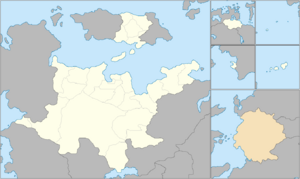Portal:Caphiria
Welcome to the Caphiria Portal!

|
|
 Left: Mainland Caphiria; Top right: Escal Isles; Center-right: Zaclaria; Bottom left: Coribus; Bottom right: Shenendehowa Bay | |
Caphiria, officially the Fourth Imperium of Caphiria, is a caesaropapist constitutional republic on Sarpedon. Caphiria is composed of 25 mainland provinces, 2 Overseas Provinces, and 5 Overseas Possessions. At over 2.3 million square miles and with a population of over 617 million, Caphiria is the world's second-largest country by total area and the second-most populous country. The capital of Caphiria is Venceia, which is also the largest city by population in Caphiria and the second-largest in the world with over 50 million people.
Inhabited since at least the Palaeolithic era, Caphiria can trace its origin to a geographic region called Latium that encompassed the southern part of Levantia and the northern part of Sarpedon. Latium played a pivotal role in the development of a number of diverse cultural groups and civilizations, most notably the Adonerii civilization, an ancient thalassocratic civilization that controlled the partial coastlines of what is now Urcea, Caphiria, Cartadania, and Burgundie. After the collapse of Adonerum in the 6th century BC, the ancient Latinics emerged as a dominant ethno-cultural group and spread the Latinic language, ancestry, history, and culture throughout the continent. In 480 BC, the Kingdom of Caphiria was founded by Lanintius, a popular and successful Latinic general. The kingdom lasted over a century until the last king Admoneptis was overthrown in a coup d'état and the Republic of Caphiria was established, lasting almost 500 years until 109 AD. The Republic saw a vast expansion of territory, including present-day Cartadania and Pelaxia, but also saw internal pressure from various ambitious leaders and the aristocracy, leading to the War of the Republic which saw Caphiria transition from Republic to Empire. In 136 AD, the First Imperium was established, which saw Caphiria experiencing a vigorous expansion of its territory, having regional dominance and ultimately total control of more than half of the Sarpedon. In the late 9th century, the First Imperium collapsed in on itself due to political instability stemming from the lingering effects of the War of the Republic and after a 10-year interregnum, the Second Imperium was established in 900. This government was plagued with issues from the start and quickly reignited more conflict however, and lead to a massive four-decade conflict of civil war known as the Great Civil War in 1127. The civil war led to the quick collapse of the Second Imperium and left Caphiria in a highly vulnerable position from outside threats.
Due to the stresses and strains from the Great Civil War, such as chronic usurpations, military insurrections, and simultaneous military conflicts across multiple frontiers, Caphiria was in a highly weakened state and the collapse of the Second Imperium brought with it a series of barbarian invasions. This ushered in Caphiria's dark age, known as the Dark Period. Between the late 12th and 13th centuries, the empire was severely fragmented as the Senate agreed to let most of its provinces become pseudo-independent states controlled by local Sarpic warlords while it usurped control over Venceia and effectively reverted back to being a Republican city-state. Eventually, Șerossaccir Odobricci, a Latino-Slavic warlord of Truřov (one of the established warlord states), began a successful military campaign of conquering his neighbors and reuniting the lost provinces of the empire.In 1283, Șerossaccir became the next Imperator and established the Third Imperium which saw the reunification of the state, the creation of the Constitution of Caphiria, and the establishment of dozens of Latino-Slavic dynasties and cultural/political institutions. Subsequent decades saw a period of optimism, cultural and scientific flourishing, as well as economic prosperity. At the same time, the Great Schism of 1615, where a break of communion between what are now the Catholic Church and the Imperial Church of Caphiria occurred. The Great Schism lead to the dissolution of the Western Provinces and the independence of countries such as Cartadania in 1615, Pelaxia in 1618, and Aciria in 1625. The final blow to the Third Imperium was the Veltorine War of Independence in the late 17th century, in which Caphiria lost its eastern provinces. The collapse of the Third Imperium marks Caphiria's transition into the modern era. (Full article...)
Gladiatorial combat (Caphiric Latin: Gladiatura) is a hybrid martial art combat blood sport where participants compete in individual combat tournaments. The sport is a full-speed, full-force, full-contact competition, with participants - known as gladiators, who are usually protected by a carbon-fiber armored suit known as the Lorica system.
The roots of gladiatorial combat can be traced back two millennia to ancient Caphiria where were mostly slaves fighting with other slaves, wild animals, and condemned criminals served as entertainment for the public. It was not long before volunteers would begin risking their lives and their legal and social standing by appearing in the arena to fight for glory, fame, notoriety, and eventually, freedom. These volunteers, known as gladiators, were celebrated in art, and their value as entertainers increased. Eventually, gladiators became an essential feature of politics and social life in the Caphiric world. (Full article...)Page Template:Collapse top/styles.css has no content.
List of Featured articles
|
|---|
The page "Portal:Caphiria/Selected biography/9" does not exist.
Did you know –
The page "Portal:Caphiria/DYK/3" does not exist.
